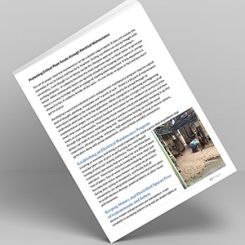An equipment manufacturer provides a secure monitoring solution to a utilities authority.
01/07/2015
To manage data from remote systems such as pump stations, overflow tanks or wells, most water treatment systems rely on a supervisory control and data acquisition (SCADA) system. Remote terminal units (RTUs) collect data for digital and analog inputs at each of the remote sites (see Image 1). The RTUs also provide control functions through digital and analog outputs at remote locations. Each station must communicate data back to a central control center, which is often located several miles from the RTUs (see Image 2).
 Image 1. This RTU control panel, located in one of the pump stations, communicates wirelessly with the control panel shown in Image 2, which is in the main control room. (Images and graphics courtesy of Phoenix Contact)
Image 1. This RTU control panel, located in one of the pump stations, communicates wirelessly with the control panel shown in Image 2, which is in the main control room. (Images and graphics courtesy of Phoenix Contact) Image 2. The wireless modules in this main control room panel receive the data from the remote pump sites.
Image 2. The wireless modules in this main control room panel receive the data from the remote pump sites.
Case Study
The Northwest Bergen County Utilities Authority (NBCUA) in Waldwick, New Jersey, serves about 75,000 people. Its wastewater plant treats approximately 10.3 million gallons of wastewater each day before releasing it to the Ho-Ho-Kus Brook. Each local municipality owns and is responsible for its collection system. NBCUA owns and operates the interceptor and pumping station system.The Challenge
In the past, NBCUA used leased lines to connect the RTUs in its distributed pumping stations to the master SCADA at its plant in Waldwick, New Jersey. According to NBCUA wastewater treatment plant supervisor Rob Genetelli, “[Leased] lines were incredibly unreliable and took days to have fixed.” The communications medium needed to be replaced, and the old RTUs, which were designed to work only over leased lines, needed to be upgraded. Additionally, the new primary communications path, which is through the cellular network, is prone to fluctuations in availability. This is particularly true in times of emergency, such as during Superstorm Sandy. For this reason, the authority required a backup means of communication. NBCUA required that the new RTUs interact seamlessly with its existing SCADA host so the system would have the same appearance to the operators who make critical decisions based on the data.The Solution
NBCUA worked with an automation manufacturer to develop a new RTU that would meet these challenges. The manufacturer’s team applied their engineering know-how to design and build packaged RTUs that met the project requirements. The pump stations are several miles from the treatment plant where the SCADA host is located. Each new RTU includes an industrial modem. These modems can send and receive messages using the short message service (SMS) protocol, available on many cellphones. Using the SMS message service makes it easy for maintenance personnel to monitor inputs and control outputs on the modem. These modems also establish secure virtual private network (VPN) communications through the cellular network and Internet (see Figure 1). A VPN sets up a secure tunnel connection between networks or end devices, no matter where they are located. This situation creates a private network over an otherwise public network. Each Ethernet modem also functions as a firewall, protecting the industrial control system (ICS) from accidental or intentional cyber threats. Figure 1. An illustration of a secure VPN connectivity via a cellular connection between the pumping station and the master SCADA location
Figure 1. An illustration of a secure VPN connectivity via a cellular connection between the pumping station and the master SCADA location Image 3. The antenna transmits the signal from the pumping station to the main control room.
Image 3. The antenna transmits the signal from the pumping station to the main control room. Image 4. The PLCs use many I/O modules in the wireless application.
Image 4. The PLCs use many I/O modules in the wireless application.
